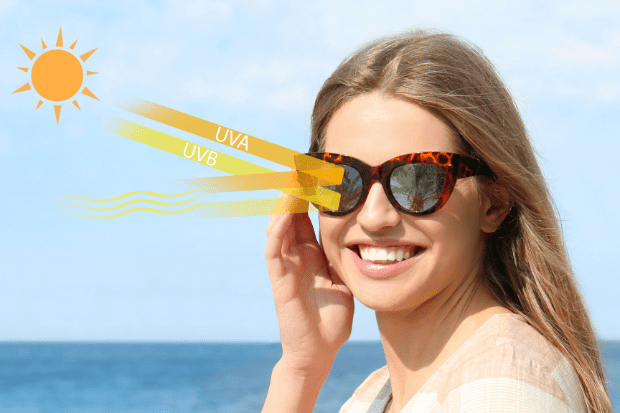How Does UV Light Affect Your Eyes?

Ultraviolet light is a form of radiation that is found in natural sunlight. The wavelengths of these light rays are shorter than light we can “see,” making them invisible to the human eye.
Although we can’t see these light rays, they can cause damage to all types of cells—including your skin and eyes.
Learn more about UV rays and the specific damage they can cause to your eyes and vision.
What is UV Light?
UV light, or ultraviolet light, is a type of ultraviolet radiation naturally found in sunlight. The sun’s rays contain many different kinds of light, but certain forms of ultraviolet beams, in particular, can cause cellular damage and change the structure of your DNA.
These rays can be difficult to avoid because they are invisible to the human eye—some more than others.
The most harmful forms of ultraviolet light found in sunlight include:
- UV-A
- UV-B
- UV-C
Some of these types of UV light are absorbed by the earth’s ozone layer, but UV-A rays can penetrate through layers of your skin, and UV-B rays can cause direct damage to exposed skin and other tissues.
The Effects of UV Light on Eyes
UV light can cause damage to your eyes by exposure to the surface and the penetration of these rays to deeper layers of your eye. Some effects of UV light are temporary, but most of the problems this type of radiation can cause for your eyes and vision health are long-term.
Short-term effects
The primary short-term effect of UV light on your eyes is a temporary reduction or loss of vision. This problem, called photokeratitis, is irritation or pain that develops after UV exposure. It’s sometimes called snow blindness and often happens when concentrated beams of UV light are reflected off water or snow into your eye.
Long-term effects
UV rays can cause temporary vision problems, but a bigger concern is the lasting health problems they can cause.
UV radiation is considered a risk factor for the development of many forms of eye disease, including:
- Cancer
- Cataracts
- Growths on the eye (pterygium)
- Age-related macular degeneration (AMD)
UV risk factors
People who work or spend a lot of time outside are at a high risk of developing vision problems from UV radiation, but some types of UV rays can also be found in different forms of artificial light. Aside from sunlight, exposure to UV radiation from tanning booths is also a common source of skin and eye problems.
Protecting Your Eyes from UV Light
The most important thing you can do to avoid the damaging effects of ultraviolet radiation is to put a barrier between your eyes and these waves of light. There are several ways this can be accomplished.
Wear a hat
Hats, especially those with a generous brim, can help shield your eyes from UV rays when you are outdoors. Certain hat materials can also offer additional protection or filtering of UV rays.
Plan your time
Avoiding the sun and UV radiation during certain hours of the day is also important. Even with protection from ultraviolet radiation, it’s important to know that the middle of the day is when ultraviolet exposure risk is the highest. Avoiding activities where you are directly in the sun—especially without protection—during these times of day can also reduce your risk of ultraviolet damage.
Wear sunglasses
Sunglasses provide a physical barrier for your eyes, protecting them from the damaging effects of ultraviolet rays. Not all sunglasses offer UV protection, so make sure you are wearing sunglasses designed to deflect these rays away from the surface of your eye. Most sunglasses that offer UV protection are labeled as such. OvernightGlasses.com offers a wide variety of sunglasses that fall into this category, and you can even order them with prescription-strength vision correction.
Add protection to your eyeglasses
If you already wear glasses, adding special coatings to your lenses can be a convenient way to get protection from the sun. A wide range of coatings can be added to prescription and non-prescription lenses. Polarized or anti-reflective coatings can help block ultraviolet radiation, and even coatings can offer light-blocking power that automatically transitions when you move from light to dark areas.
If you don’t want to wear separate pairs of prescription sunglasses and regular eyeglasses, these special coatings can offer UV protection and vision correction in a single device.
Conclusion
Ultraviolet light exposure is linked to problems like skin cancer, eye cancer, and other vision issues like cataracts. These harmful rays are found naturally in sunlight but also in some forms of artificial light.
You can protect your eye health and vision with sunglasses or UV-blocking coatings added to your regular eyeglasses. Shielding your eyes from these light rays is the best protection against long-term damage from ultraviolet radiation.
